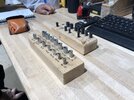Context: We are a producer of industrial battery chargers. These chargers physically appear as a protective envelope which is as big as an industrial refrigerator. The enclosure is assembled by us. On the different metal panels constituting the enclosure, there are small cylinders with internal thread.
Non-compliance: During an internal audit, the auditor saw an unidentified, uncalibrated thread gage kit, and he also believed that some of these gages were worn. Its exact verbatim is as follows: “For the receiving inspection of mechanical components, the threads are checked with threaded ends, not with valid / calibrated thread plug (go-no/go) and this, for all sizes of threads”. He based his NC on requirement 7.1.5.1 Measurement Traceability, which states: “The organization must maintain appropriate documented information demonstrating the adequacy of resources for monitoring and measurement. »
The Question: Is procuring ouserlves with valid / calibrated thread plugs (go-nogos) for all sizes of threads checked the recommended course of action? These gages are probably very expensive. This equipment only serves to “validate” to a certain extent whether the supplier has the metal panels with the right threads e.g. we don’t need precision as in the aviation industy !
Thanks in advance to anyone who can enlighten me!
LesPiles
Non-compliance: During an internal audit, the auditor saw an unidentified, uncalibrated thread gage kit, and he also believed that some of these gages were worn. Its exact verbatim is as follows: “For the receiving inspection of mechanical components, the threads are checked with threaded ends, not with valid / calibrated thread plug (go-no/go) and this, for all sizes of threads”. He based his NC on requirement 7.1.5.1 Measurement Traceability, which states: “The organization must maintain appropriate documented information demonstrating the adequacy of resources for monitoring and measurement. »
The Question: Is procuring ouserlves with valid / calibrated thread plugs (go-nogos) for all sizes of threads checked the recommended course of action? These gages are probably very expensive. This equipment only serves to “validate” to a certain extent whether the supplier has the metal panels with the right threads e.g. we don’t need precision as in the aviation industy !
Thanks in advance to anyone who can enlighten me!
LesPiles

